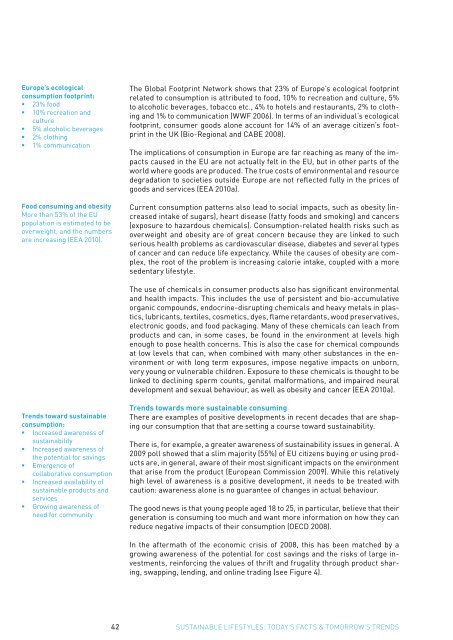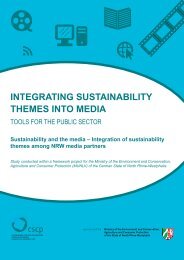today's facts & tomorrow's trends - SPREAD Sustainable Lifestyles ...
today's facts & tomorrow's trends - SPREAD Sustainable Lifestyles ...
today's facts & tomorrow's trends - SPREAD Sustainable Lifestyles ...
Create successful ePaper yourself
Turn your PDF publications into a flip-book with our unique Google optimized e-Paper software.
Europe’s ecological<br />
consumption footprint:<br />
• 23% food<br />
• 10% recreation and<br />
culture<br />
• 5% alcoholic beverages<br />
• 2% clothing<br />
• 1% communication<br />
Food consuming and obesity<br />
More than 53% of the EU<br />
population is estimated to be<br />
overweight, and the numbers<br />
are increasing (EEA 2010).<br />
The Global Footprint Network shows that 23% of Europe’s ecological footprint<br />
related to consumption is attributed to food, 10% to recreation and culture, 5%<br />
to alcoholic beverages, tobacco etc., 4% to hotels and restaurants, 2% to clothing<br />
and 1% to communication (WWF 2006). In terms of an individual’s ecological<br />
footprint, consumer goods alone account for 14% of an average citizen’s footprint<br />
in the UK (Bio-Regional and CABE 2008).<br />
The implications of consumption in Europe are far reaching as many of the impacts<br />
caused in the EU are not actually felt in the EU, but in other parts of the<br />
world where goods are produced. The true costs of environmental and resource<br />
degradation to societies outside Europe are not reflected fully in the prices of<br />
goods and services (EEA 2010a).<br />
Current consumption patterns also lead to social impacts, such as obesity (increased<br />
intake of sugars), heart disease (fatty foods and smoking) and cancers<br />
(exposure to hazardous chemicals). Consumption-related health risks such as<br />
overweight and obesity are of great concern because they are linked to such<br />
serious health problems as cardiovascular disease, diabetes and several types<br />
of cancer and can reduce life expectancy. While the causes of obesity are complex,<br />
the root of the problem is increasing calorie intake, coupled with a more<br />
sedentary lifestyle.<br />
The use of chemicals in consumer products also has significant environmental<br />
and health impacts. This includes the use of persistent and bio-accumulative<br />
organic compounds, endocrine-disrupting chemicals and heavy metals in plastics,<br />
lubricants, textiles, cosmetics, dyes, flame retardants, wood preservatives,<br />
electronic goods, and food packaging. Many of these chemicals can leach from<br />
products and can, in some cases, be found in the environment at levels high<br />
enough to pose health concerns. This is also the case for chemical compounds<br />
at low levels that can, when combined with many other substances in the environment<br />
or with long term exposures, impose negative impacts on unborn,<br />
very young or vulnerable children. Exposure to these chemicals is thought to be<br />
linked to declining sperm counts, genital malformations, and impaired neural<br />
development and sexual behaviour, as well as obesity and cancer (EEA 2010a).<br />
Trends toward sustainable<br />
consumption:<br />
• Increased awareness of<br />
sustainability<br />
• Increased awareness of<br />
the potential for savings<br />
• Emergence of<br />
collaborative consumption<br />
• Increased availability of<br />
sustainable products and<br />
services<br />
• Growing awareness of<br />
need for community<br />
Trends towards more sustainable consuming<br />
There are examples of positive developments in recent decades that are shaping<br />
our consumption that that are setting a course toward sustainability.<br />
There is, for example, a greater awareness of sustainability issues in general. A<br />
2009 poll showed that a slim majority (55%) of EU citizens buying or using products<br />
are, in general, aware of their most significant impacts on the environment<br />
that arise from the product (European Commission 2009). While this relatively<br />
high level of awareness is a positive development, it needs to be treated with<br />
caution: awareness alone is no guarantee of changes in actual behaviour.<br />
The good news is that young people aged 18 to 25, in particular, believe that their<br />
generation is consuming too much and want more information on how they can<br />
reduce negative impacts of their consumption (OECD 2008).<br />
In the aftermath of the economic crisis of 2008, this has been matched by a<br />
growing awareness of the potential for cost savings and the risks of large investments,<br />
reinforcing the values of thrift and frugality through product sharing,<br />
swapping, lending, and online trading (see Figure 4).<br />
42<br />
SUSTAINABLE LIFESTYLES: TODAY’S FACTS & TOMORROW’S TRENDS
















